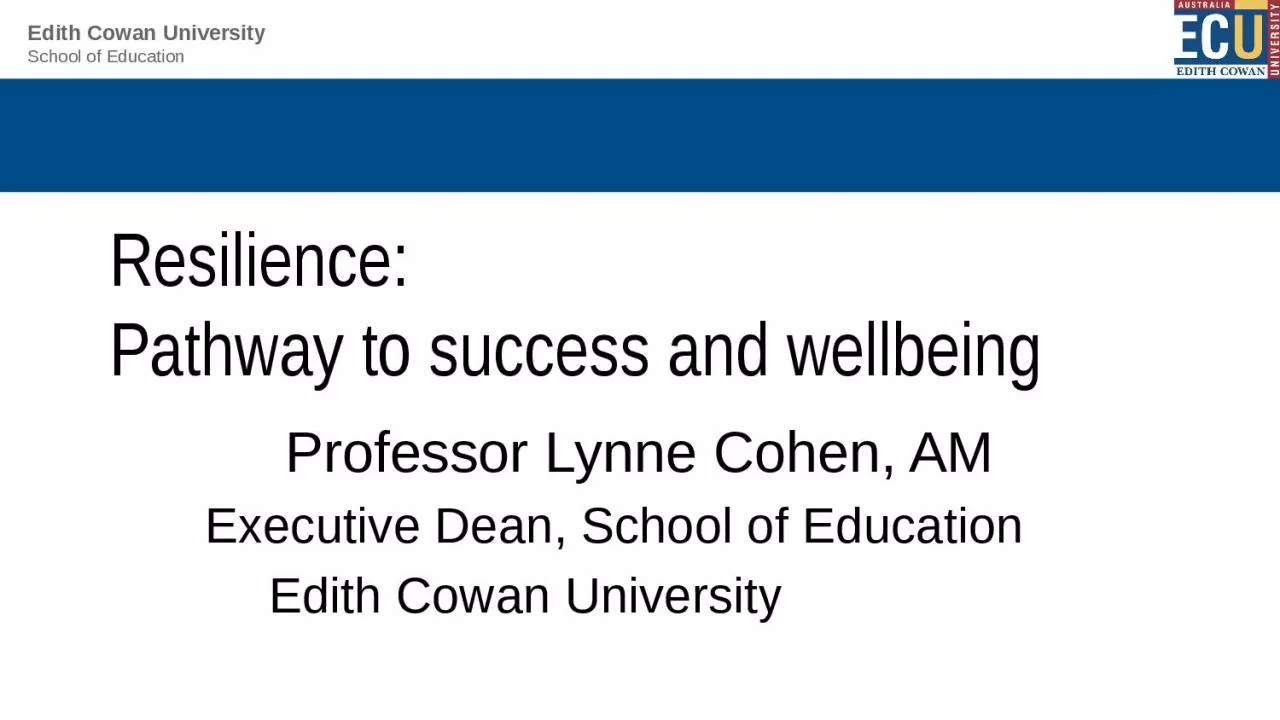

Professor Lynne Cohen AM Executive Dean School of Education Edith Cowan University Resilience Pathway to success and wellbeing Structure for todays presentation What is resilience Definition ID: 1018650
Download Presentation The PPT/PDF document "Resilience: Pathway to success and well..." is the property of its rightful owner. Permission is granted to download and print the materials on this web site for personal, non-commercial use only, and to display it on your personal computer provided you do not modify the materials and that you retain all copyright notices contained in the materials. By downloading content from our website, you accept the terms of this agreement.
1. Resilience: Pathway to success and wellbeing Professor Lynne Cohen, AMExecutive Dean, School of Education Edith Cowan University
2. Resilience: Pathway to success and wellbeingStructure for today’s presentation:What is resilience?/ Definition of resilienceWhat does success look like?Defining wellbeingHow does resilience provide a pathway to success and wellbeing?
3. What is resilience?Often referred to as ‘bouncing back from adversity’Develops as the result of a struggleHaving a positive view on life assists with resilience (Wang, Li & Li, 2016)
4. Definition of Resilience‘. . . the potential to exhibit resourcefulness by using available internal and external resources in response to different contextual and developmental challenges” (Pooley & Cohen, 2010, p. 34).
5. What does success look like?
6. Definition of ‘wellbeing’Dictionary definition:“good or satisfactory condition of existence; a state characterized by health, happiness, and prosperity” (www.dictionary.com)
7. Context for today’s presentationWhile resilience is important across the lifespan and may be affected by similar events that produce similar outcomes, today I will focus on the contexts of children and youth.
8. Resilience – nature vs nurtureSome people are born more resilient than others (nature)People need guided negative experiences to develop resilience (nurture)Resilience can be learned!!! Even at an early age.
9. Five waves of Resilience Research Wave 1: An emphasis on individual characteristics that make people resilientWave 2: An emphasis on resilience processes (i.e., the relationships between a collective of individual and environmental factors that improve resilience at the end)Wave 3: An emphasis on interventions to foster resilienceWave 4: An emphasis on interactions between multiple-systems levels, including children’s internal systems (neurobiological processes) and external systems/contextWave 5: An emphasis on emancipatory function of resilience (i.e., potential to overcome adversity and oppression) with an ecological orientation
10. 11 Key Points for Resilience Building1. Have an adult they trust who helps them through life2. Have support with getting the very basics in life, like food, clothing, transport and housing3. Actually access activities, hobbies and sports4. Have multiple opportunities to practise problem-solving at home, school and in the wider community
11. 11 Key Points for Resilience Building5. Feel safe, and can be themselves in their homes, schools and communities6. Know how to calm themselves down and take charge of their feelingsKnow what they are good at, and are proud of itSupport other people, for example, through volunteering and peer mentoring
12. 11 Key Points for Resilience Building9. Are supported to understand what they need to do to build their own resilience and support other people in their communities to build theirs10. Know that all adults in their lives are enabled to help disadvantaged children build resilience, at any time and in any place11. Have help to map out a sense of future (hope and aspirations) and develop life skills
13. How do we develop resilience? beliefs about self resources (knowledge, skills)
14. Building worthRelationshipsPurpose
15. Worth – when it goes wrong Young peopleRisk takingSocial mediaAppearance Possessions Academic achievement Sports Adults OccupationHouseMarital and child status Social mediaAppearance Possessions
16. ANTISOCIAL OR CRIMINAL BEHAVIOURAGNEW’S GENERAL STRAIN THEORYFAILURE TO ACHIEVE POSITIVELY VALUED STIMULILOSS OF POSITIVELY VALUED STIMULIPRESENTATION OF NEGATIVELY VALUED STIMULIIIIIIIDROPPING OUTSUBSTANCE USEDELINQUENCYVIOLENCECRIMEDISAPPOINTMENTANGERFRUSTRATIONFEARSOURCENEGATIVE AFFECTIVE STATES
17. Agnew’s General Strain Theory The strains more relevant to offending are “severe, frequent, of long duration, or involving matters of high importance to the individual (Brezina, 2017, p. 4)
18. GST and ResilienceGST suggests that stresses and strains may at their worst represent themselves in substance abuse, self harm, and/or criminal behaviour Resilience may protect young people from the worst of the negative emotions and if this is achieved, from the worst of the negative behaviours
19. What has been found?
20. Coping: Emotions
21. Coping: Problem solving
22. Maintain your Resilience
23. What now? Action!!!Identify the needs of the studentsKeep providing opportunities to develop skills- accessing internal and external resourcesKeep showing people they are of value
24. SummaryResilience can be learned but is based on overcoming negative experiencesNegative experiences that are not resolved can lead to negative emotions and negative behaviours (GST)
25. Summary (cont’d)In developing resilience the individual needs to experience a negative event, but realise that they are worthy and able to cope; and have support to help them work through the issue – this is the key to developing resilience for success and wellbeing
26. ReferencesAgnew, R. (1992). Foundation for a General Strain Theory of Crime and Delinquency. Criminology, 30(1), 47 - 87. Brezina, T. (2017). General Strain Theory, Criminological Theory. Oxford Research Encyclopedia of Criminology. doi 10.1093/acrefore/9780190264079.013.249Hart, A., & Heaver, B., (2015). Developing Resilience. Resilience Approaches to Supporting Young People’s Mental Health: Appraising the Evidence Base for Schools and Communities, http://www.boingboing.org.uk/wp-content/uploads/2017/02/bb-guide-to-school-community- resilience-programmes-2015a.pdf. Pooley, J.A. & Cohen, L. (2010). Resilience:A definition in context. Australian Community Psychologist, 22(1), 30-37The GST diagram is adapted from Siegel, L. J. (2018). Criminology: Theories, patterns and typologies (13th ed.). Boston, MA: Cengage LearningPictures in this presentation came from Adobe Stock - https://stock.adobe.com/au/